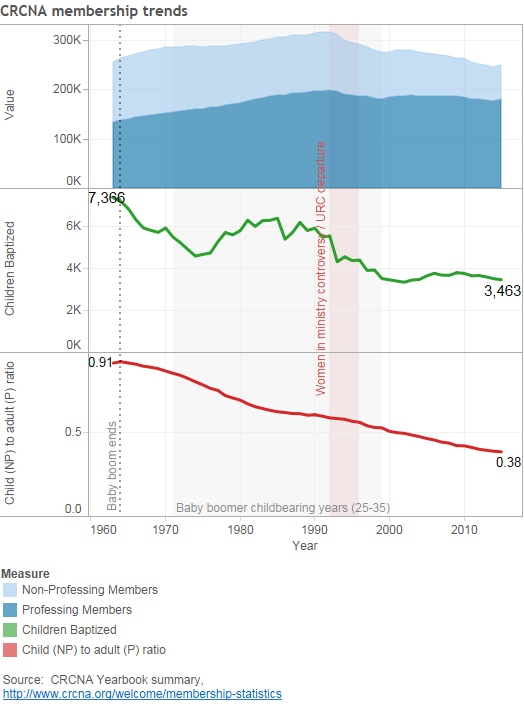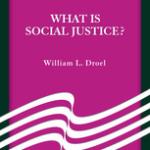I’ve been promising you charts. Time to deliver!
Believers shouldn’t be shy about calling sin “sin” and calling heresy “heresy.” But we also have to be careful not to make a bad diagnosis that calls down judgment for the wrong reasons. As I discussed in a previous post, we sin-stained human beings have cognitive biases that cause us to prefer to blame people for accidents of nature. That goes for groups, too. Shouldn’t we apply the judge-not principle to collectives as well as individuals?
Let me illustrate with a case that’s close to home. I’m a member of the Christian Reformed Church in North America, which “owns” Calvin College. The CRC is a small denomination in the US and Canada with just over 245,000 members in 2015, down 23% from a peak of 316,000 in 1992. What accounts for the decline?
Figure 1
Over the years, I’ve heard several armchair curmudgeons offer the diagnosis illustrated by the red text and pink band in Figure 1: the early 1990s were marked by an exodus of thousands of conservative members and dozens of churches, forming the United Reformed Church, for example. They left partly due to discomfort with the denominational Synod’s decision in 1990 to allow congregations to ordain women for ministry. The curmudgeons’ claim? “If we hadn’t ordained women back then, we’d still be growing now.” Their implication is that God would bless our faithfulness to traditional gender roles with more adherents to the denomination.
There’s no doubt that the controversy cost the denomination numbers. The membership decline is especially steep in the shaded region. But does the counterfactual claim hold up that the CRC would have grown if the controversy had been suppressed?
No.
The roots of our shrinking membership start outside the CRC and before the chart’s left end, with the postwar baby boom.
To appreciate a more basic underlying cause of our decline, we have to look beyond the top-line numbers. First, let’s break down the numbers by “professing members” (until 2011, this included only adults who’ve made a public profession of faith) and “non-professing members” (members who’ve not made a profession of faith, who are almost exclusively baptized children and infants).
Figure 2
As the dark blue area of Figure 2 shows, adult membership has been fairly stable since the early 90s, fluctuating between 175,000 and 187,000 members. Meanwhile, the light blue area continues to shrink. We’re having fewer babies. Figure 3 uses a ratio to demonstrate the trend very starkly:
Figure 3
The green line at the top of Figure 3 shows the number of babies born. CRC denominational growth in the 1980s was largely an echo of the baby boom, while the original Boomers were in their peak childbearing years.
But the clincher is the red line at the bottom of Figure 3, which shows a ratio, the number of non-professing members (children) for every professing member (adult). Since 1962, there has only been one year in which the ratio increased: 1963. It’s been all downhill since then. If God is judging the CRC for our attitude toward gender roles, He started His work at least as far back as the early 1960s.
Figure 4 is a static graphic that puts it all together:
Figure 4

Takeaways
I offer you Carlson’s Corollary to Hanlon’s Razor:
Never attribute to heterodoxy that which is adequately explained by demography.
In more Biblical terms, don’t blame your fellow believers for a generational “sin” you and your generation have also committed. (Got 3 or more kids? OK, you have a license to judge.)
The CRC isn’t shrinking primarily because our doctrine drove away conservatives in the 1990s. We are richer, better educated, and longer lived, so we’re delaying marriage and childbirth and having fewer kids, right along with everyone else in the USA and Canada. Without some means to generate our very own baby boom (perhaps by welcoming immigrants?), we were destined by demography to start shrinking in the 90s. In fact, as I’ve noted before, a huge share of trends in religious affiliation can be explained by birth rates alone.
The good news is that the CRC saw a small membership uptick from 2014 to 2015, a fact celebrated at the 2015 Synod. Now that young children may make profession of faith, it will take time to tell whether we’re gaining much ground, but it’s a start.
What do you observe in your congregation or denomination? Does your faith community first eliminate the mundane before you diagnose angels and demons, miracles and malfeasance? Do you know of some good current research on religious demographics? Please comment below or on our Facebook page!
The next post brings us back to the social science of leadership. How do we get other people to do what we ask them to? We’ll review the work of John Brehm and Scott Gates on IRS agents, social workers, and police officers.










